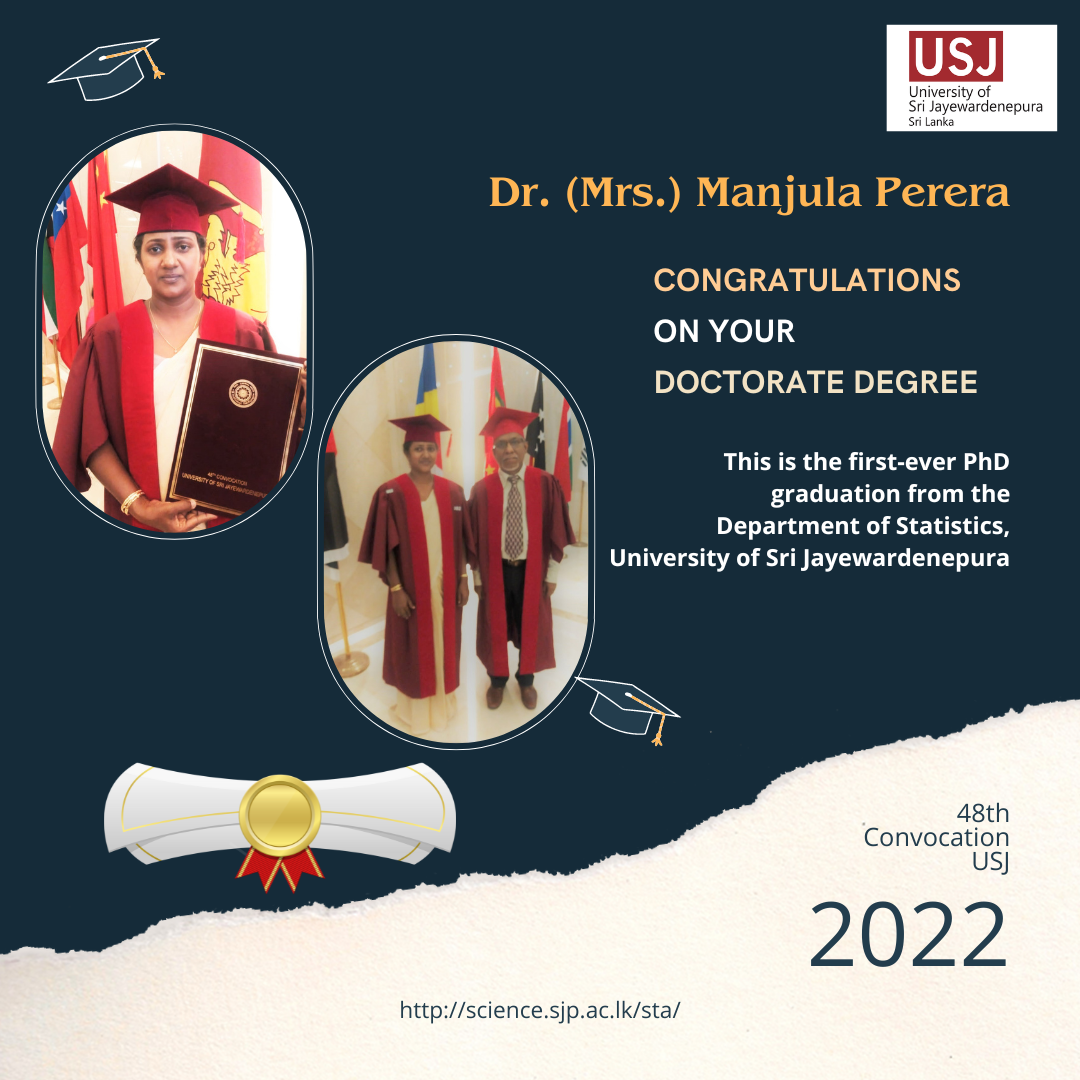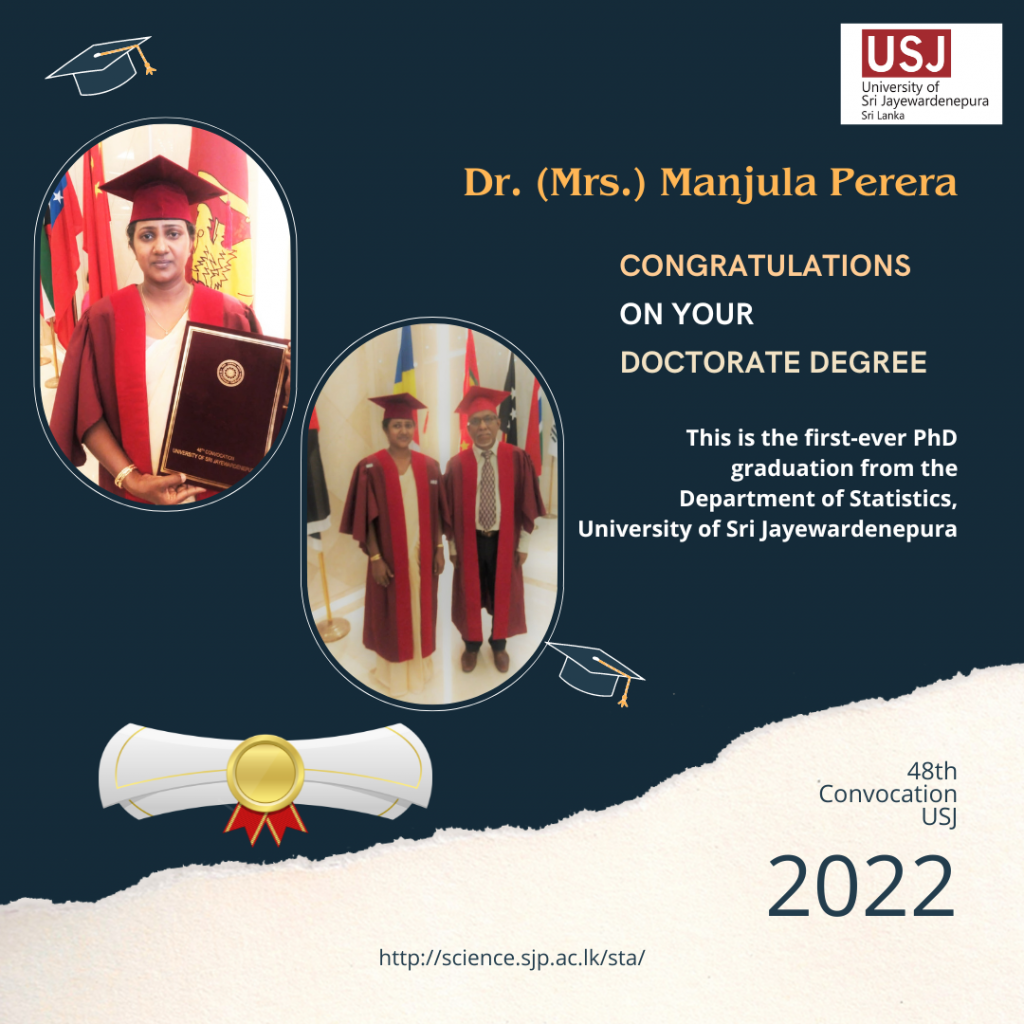At the 48th convocation of USJ, the first-ever PhD graduate from the Department, Dr. Manjula Perera was conferred. Her primary supervisor was Dr. Ravindra Lokupitiya of the Department of Statistics, USJ. Her PhD thesis title was “Estimation of global scale carbon fluxes using Maximum Likelihood ensemble filter“. She was co-supervised by the following academics:
- Prof. A. Scott Denning, Professor, Department of Atmospheric Science, Colorado State
University, Fort Collins, CO 80523-1371 USA. - Prof. E. Y. K. Lokupitiya, Professor in Environmental Science, Department of Zoology
and Environment Sciences, University of Colombo, Colombo, Sri Lanka. - Dr. Prabir Kumar Patra, Principal Scientist, Research Institute for Global Change,
JAMSTEC, 3173-25 Showa-machi, Kanazawa-ku, Yokohama, 236-0001, Japan. - Prof. R. G. N. Meegama, Professor in Computer Science, Department of Computer
Science, Faculty of Applied Sciences, University of Sri Jayewardenepura, Gangodawila,
Nugegoda, Sri Lanka.
Dr. Perera would like to thank the following institutes for the grants she received for her PhD studies.
- National Research Council, Sri Lanka (NRC-036)
- Asia-Pacific Network for Global Change Research (APN); grant#ARCP2011-11NMY-
Patra/Canadell).
Her thesis abstract is as follows:
More advanced data assimilation methods based on statistical and mathematical knowledge are needed to cater to the increased amount of CO2 measurements collected in various platforms. In addition to existing flasks, continuous and aircraft data, CO2 measurements obtained by passenger aircrafts and satellites increase the observation network and provide more constraints on surface carbon flux estimation. This thesis mainly focuses on estimating the surface carbon sources and sinks using CONTRAIL aircraft observations, in addition to the existing in-situ measurements using the ensemble based data assimilation method called Maximum Likelihood Ensemble Filter (MLEF) coupled with Parameterized Chemistry Transport model (PCTM). A pseudodata experiment was carried out by adding CONTRAIL measurements to the observation vector using MLEF coupled with PCTM model, which was driven by GEOS-4 (Goddard Earth Observation System, version 4) weather data for the model validation. Next, MLEF code was developed to conduct the real data experiment to identify the capability on estimating surface carbon fluxes for the period 2009-2011. PCTM model was driven by Modern-Era Retrospective analysis for Research and Applications, Version 2 (MERRA2) weather data. Solving separate multiplicative biases added for photosynthesis, respiration, and air-sea gas exchange fluxes the estimated fluxes were obtained. Hourly land fluxes, Gross Primary Production (GPP) and respiration obtained from Simple Biosphere-version 3 (SiB3) model, Takahashi ocean fluxes and Brenkert fossil fuel emissions were used.
Pseudodata experiment results showed a considerable uncertainty reduction for Asian region and more than 50% reduction for North American and European regions. According to the results of the real data experiment, North America showed about 60-80% uncertainty reduction while the Asian and European regions showed moderate results with 50-60% uncertainty reduction. Most other land and oceanic regions showed less than 30% uncertainty reduction. The results were mainly compared with the results of well-known CarbonTracker (CT2017) which is a CO2 measurement and modeling system developed by NOAA (National Oceanic and Atmospheric Administration). The spatial distribution of estimated mean annual fluxes over North America, Australia and Tropical Asia showed good agreement with the CarbonTracker results when aggregated into large regions. The biases were poorly constrained in the regions where the CO2 observations are not sufficiently dense such as South America and Africa. Long-term averaged fluxes were compared with several other inversion studies and showed similar results for the Boreal North America, Temperate North America and Australia. The results reveal the capability of MLEF method to assimilate large CO2 observation vectors with high performance parallel computing environment with less cost and less time. The impact of satellite observations with MLEF needs to be investigated further and this study forms the basis of the future work in this area.
Keywords: Data assimilation, Maximum Likelihood Ensemble Filter, CONTRAIL aircraft observations, Carbon sources and sinks, CO2 modeling



